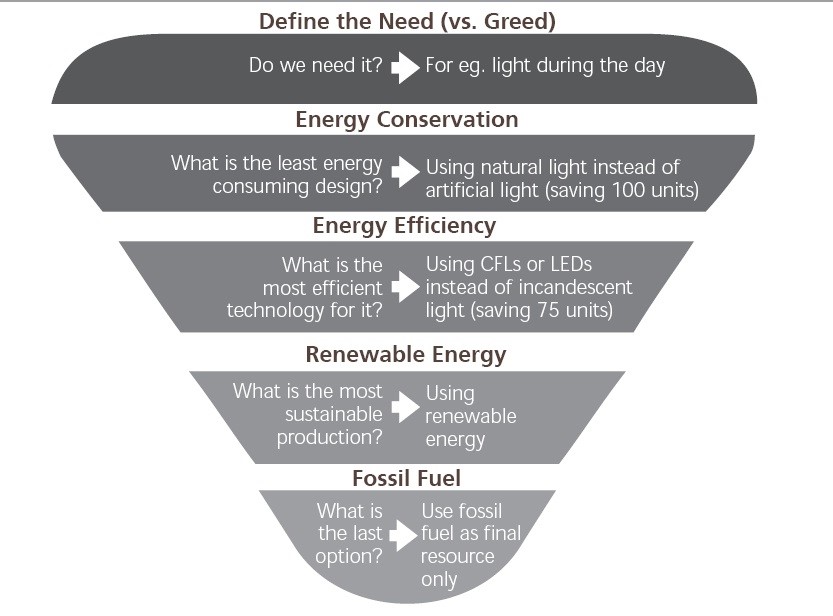Mr Toine van Megen | Co-founder, Auroville Consulting
Achieving net-zero energy
The Energy Pyramid
The road map towards net-zero energy buildings or urban settlements includes the steps as shown in the energy pyramid below.
Defining “need” versus “greed” is a subjective exercise but most of us will agree that the very low temperatures that we experience in many five star hotel lobbies and conference halls do not fulfil an actual need and that the same applies to lighting levels in some offices and homes. This part of the exercise deals also with a lifestyle choice and is an essential part of the road map towards net-zero energy.
Energy conservation can be achieved in various ways. In the case of ventilation it is the use of natural cross ventilation and in the case of lighting it involves striking a balance between daylight and outdoor heat penetration.
Energy efficiency can be achieved in numerous ways as well and we now have lighting, cooling, and heating technologies that use only a fraction of the energy of conventional equipment and appliances.
It is after we have addressed the above three issues of need, conservation and efficiency that we look into distributed generation including rooftop solar PV systems with the objective of achieving net-zero energy buildings or building clusters.
Enabling distributed renewable energy generation
In our work with regulators and policy makers we have introduces two mechanisms that promote the optimal use of good solar roofs as explained below.
Group Net-Metering
To encourage solar plants on rooftops of buildings that cannot consume all of the energy generated locally, there is the facility of Group Net Metering, whereby surplus energy exported to the grid from a solar plant in excess of 100 percent of imported energy at the location of the solar plant can be adjusted in any other (one or more) electricity service connection(s) of the consumer within the state or union territory. The purpose of this provision is to help maximize the utilization of rooftop space for solar energy generation for consumers with multiple buildings and service connections.
Virtual Net Metering
To give access to the solar net metering facility for consumers who do not have a suitable roof for installing a solar system (e.g. residential consumers who live in apartments, consumers with shaded rooftops) there can be a facility called Virtual Net Metering. In Virtual Net Metering consumers can be beneficial owners of a part of a collectively owned solar system. All energy produced by a collectively owned solar system will be fed into the grid through an energy meter and the exported energy as recorded by that meter will be pro rata credited in the electricity bill of each participating consumer on the basis of beneficial ownership. Collective ownership of solar plants may be established through societies, trusts or section 25 Companies or any other legal entity that safeguards the interests of participating consumers, including rights which are at par with the rights enjoyed by consumers who have solar net metering with a solar system installed on their own roof.
Energy Metering
A major part of the small scale solar PV segment will come under the net-metering mechanism whereby the solar energy feeds the loads of the building with the surplus energy, if any, being exported to the grid. One of the challenges faced in some states is the replacement of existing unidirectional service connection meters with bidirectional energy meters (with separate registers for the imported and exported energy).
Energy meters that are used for the registration of energy consumption by electricity consumers are nowadays of the static electronic type with the electro-mechanical meter types being phased out. Most of these static electronic meters are of the four quadrant energy measuring type and are therefore by definition bidirectional energy meters that can record and display active reactive and apparent energy in each of the four quadrants. When these energy meters are deployed by distribution licensees they are usually programmed to display the absolute total of imported and exported active energy (OBIS Code 15.8.0.): |A+| + |A-|. This is also referred to as the “forwarded energy”. This configuration setting of energy meters ensures that if consumers would fraudulently or erroneously reverse the incoming and outgoing wires in one or more phases, the reverse flow of energy (export) will not be deducted from the forward flow of energy (import) but instead be added to the forward flow.
If the same energy meter is used for solar energy net metering, the meter is configured by the manufacturer with a different parameterization scheme that displays the following active energy parameters: (1) imported active energy (OBIS code 1.8.0.): A+; (2) exported active energy (OBIS code 2.8.0.): A-; (3) the net active energy (OBIS code 16.8.0.): A+ – A-
It is proposed that all new service connection meters in the country may be configured for bidirectional energy recording and display so that all new service connections are “solar energy ready”. This can be done at no additional cost since most of the static electronic meters of reputed manufacturers in the country are already of the four-quadrant, bidirectional type and only need to be software-configured differently in the factory to get the display parameters needed for bidirectional enrgy metering. An additional advantage of this configuration is that while in the presently adopted forwarded energy configuration, unauthorized phase wire reversal is getting accounted for in the bidirectional configuration reverse energy is accounted for and detected.
Disclaimer: This website is made possible by the support of the American People through the United States Agency for International Development (USAID). The contents of this website are the sole responsibility of Environmental Design Solutions and do not necessarily reflect the views of USAID or the United States Government.

